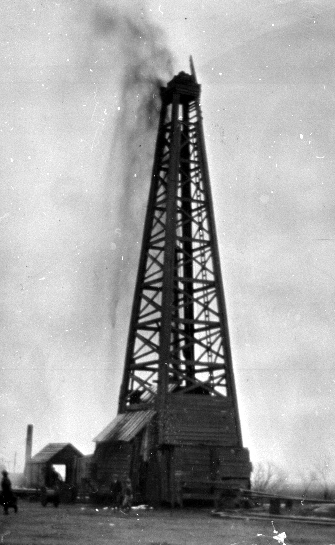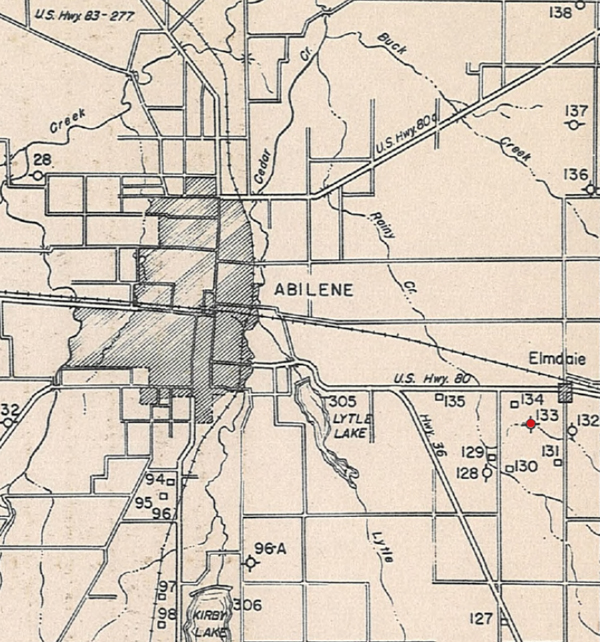
The Sanger Oil & Refining Company Anderson No. 1 well, drilled in 1927, generated brief excitement, but did not produce commercial quantities of oil. Photo courtesy Hardin-Simmons University.
With other companies making major oil discoveries at Electra, Ranger and Burkburnett in the early 1900s, Sanger Oil & Refining Company hoped to add Abilene to North Texas boom towns. For 22 years Charles Sanger drilled dry holes instead.
Electra’s Clayco No. 1 well erupted in 1911, revealing the poor, cotton-farming community was over a giant oilfield. About 100 miles south, a 1917 gusher at Ranger revealed yet another massive field.
One year later along the Red River border with Oklahoma, a discovery at Burkburnett added to North Texas oil fever. Years later even Hollywood took notice with the hit MGM movie, “Boom Town” Burkburnett.
These successive oil booms resulted in many newly formed companies rushing to the region seeking “black gold” for their investors.
However, as with the petroleum industry’s earliest booms in Pennsylvania, intense competition made drilling prospects hard to come by. Confronted with expensive dry holes, most new petroleum companies failed when investors’ oil fever cooled.

Beginning in the 1920s, Sanger Oil & Refining Company drilled many dry holes near Abilene, Texas, including the Ike Brown No. 1 well, shown here as 133 on a 1940 Texas State Board of Water Engineers map.
Sanger Oil & Refining Company
When Charles W. Sanger, a real-estate entrepreneur in an Amarillo, Texas, decided to become an oil wildcatter in 1919, he moved to Abilene and launched his new company.

A former real-estate salesman established Sanger Oil & Refining Company in Abilene, Texas, in 1920. With three other oil boom towns nearby, residents hoped for a similar oil-patch fate.
Sanger established Sanger Oil & Refining Company in Abilene on February 2, 1920, with capitalization of $1.5 million. He first tried drilling exploratory wells near the Ranger, about 60 miles to the east. His sons and their sister joined the venture despite early dry holes.
Sanger drilled his first Abilene wildcat well on the Hale farm, then another on the Bowyer’s farm, both within a few miles of town and both unsuccessful. Another well named the Anderson No. 1 produced briefly, but not commercially. Well sites (then and today) were typically named after the land owner.
Despite the bad luck, Sanger Oil & Refining continued drilling its Hall No. 1 well in 1922. Many others followed.
Many Abilene residents became shareholders in Sanger Oil & Refining. Local publications provided them with oil-patch educations.
“Oil men call a showing of oil which is non-commercial – not enough to produce and sell profitably – a ‘rainbow’ showing,” explained the Abilene Reporter. “A film of crude on the waters in a slush pit catches the sunlight and breaks the reflection into the colors of a rainbow.”
Sanger spent 22 years chasing his oily rainbows near Abilene. He drilled 30 consecutive unsuccessful wells in Abilene’s Taylor County. Disappointed investors kept their faith in him.
In 1927, Sanger Oil & Refining drilled the No. 1 Shipley, eight miles southeast of Abilene and the No. 1 Gillespie, five miles southeast. The Ike Brown (drilled to a depth of 3,514 feet) and the W.N. Osborne were also dry holes.
When Charles Sanger died in November 1941, the Abilene Reporter noted that he had “poured millions of dollars into the ground along with the mud with which he plugged one wildcat after another.”
The newspaper added that despite “several promising showings had been obtained in the earliest wildcats drilled near here about the time of his arrival, Sanger always had confidence in the discovery of a major field within sight of Abilene…Sanger never found it.”

Detail from a Bird’s Eye View lithograph of Abilene, Texas, 1883, by Augustus Koch. (3) Hotel and passenger depot of the Texas and Pacific R.R. (4) Freight depot (5) Wm. Cameron’s lumber yard. Image courtesy of Special Collections, The University of Texas at Arlington Libraries.
Abilene’s first commercial oil well was completed in 1928.
___________________________________________________________________________________
The stories of other attempts to join petroleum exploration booms (and avoid busts) can be found in an updated series of research at Is my Old Oil Stock worth Anything?
___________________________________________________________________________________
Please support the American Oil & Gas Historical Society and this website with a donation.

